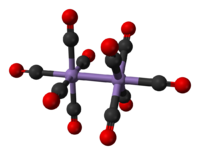- Dimanganese decacarbonyl
-
Dimanganese decacarbonyl 
 bis(pentacarbonylmanganese)(Mn—Mn)Other namesManganese carbonyl
bis(pentacarbonylmanganese)(Mn—Mn)Other namesManganese carbonyl
DecacarbonyldimanganeseIdentifiers CAS number 10170-69-1 
ChemSpider 451751 
RTECS number GG0300000 Jmol-3D images Image 1 - [Mn].[Mn].[C-]#[O+].[O+]#[C-].[O+]#[C-].[O+]#[C-].[O+]#[C-].[O+]#[C-].[O+]#[C-].[O+]#[C-].[O+]#[C-].[O+]#[C-]
Properties Molecular formula C10O10Mn2 Molar mass 389.98 g/mol Appearance yellow crystals Density 1.750 g/cm3 Melting point 154 °C
Boiling point sublimes 60 °C
(0.5 mm Hg)Solubility in water insoluble Structure Dipole moment 0 D Hazards R-phrases 23/24/25 S-phrases 22-26-36/37/39-45 Main hazards CO source Related compounds Related compounds Co2(CO)8
Fe3(CO)12
Fe2(CO)9 decacarbonyl (verify) (what is:
decacarbonyl (verify) (what is:  /
/ ?)
?)
Except where noted otherwise, data are given for materials in their standard state (at 25 °C, 100 kPa)Infobox references Dimanganese decacarbonyl is the chemical compound with the formula Mn2(CO)10. This metal carbonyl is an important reagent in the organometallic chemistry of manganese.[1]
Contents
Synthesis
The compound was first prepared in low yield by the reduction of manganese iodide with magnesium under CO.[2] A more efficient preparation entails reduction of anhydrous MnCl2 with sodium benzophenone ketyl under 200 atmospheres of CO.[3] The availability of inexpensive methylcyclopentadienyl manganese tricarbonyl ("MMT") has led to a low pressure route to Mn2(CO)10.[4]
Structure
Mn2(CO)10 has no bridging CO ligands: it can be described (CO)5Mn-Mn(CO)5. There are two kinds of CO ligands; one CO on each Mn is coaxial with the Mn-Mn bond, and four on each manganese that are perpendicular to it (equatorial). In the stable rotamer, the two Mn(CO)5 subunits are staggered. The overall molecule thus belongs to the point group D4d, which is an uncommon symmetry.
Reactions
Mn2(CO)10 is air stable as a crystalline solid, but solutions require Schlenk techniques. It finds limited use in organic synthesis.[5] Characteristic reactions:
- Reduction of Mn2(CO)10 gives the manganese pentacarbonyl anion, which can be isolated as a salt:
- Mn2(CO)10 + 2 Na → 2 Na[Mn(CO)5]
The anion is a versatile nucleophile. Protonation gives the hydride [HMn(CO)5], and methylation gives [(CH3)Mn(CO)5].
- Halogenation of Mn2(CO)10 proceeds with scission of the Mn-Mn bond.
- Mn2(CO)10 + Br2 → 2[Mn(CO)5Br]
Safety
Mn2(CO)10 is a volatile source of a metal and a source of CO.
References
- ^ Elschenbroich, C. ”Organometallics” (2006) Wiley-VCH: Weinheim. ISBN 978-3-29390-6
- ^ Brimm, E. O.; Lynch, M. A.; Sesny, W. J. "Preparation and Properties of Manganese Carbonyl" Journal of the American Chemical Society 1954, volume 76, page 3831 - 3835.
- ^ King, R. B. Organometallic Syntheses. Volume 1 Transition-Metal Compounds; Academic Press: New York, 1965. ISBN 0-444-42607-8
- ^ King, R. B.; Stokes, J. C.; Korenowski, T. F. "A Convenient Synthesis of Dimanganese Decarbonyl from Inexpensive Starting Materials at Atmospheric Pressure" Journal of Organometallic Chemistry 1968, volume 11, Pages 641-643.
- ^ Pauson, P. L. “Decacarbonyldimanganese” in Encyclopedia of Reagents for Organic Synthesis (Ed: L. Paquette) 2004, J. Wiley & Sons, New York. DOI: 10.1002/047084289.
Categories:- Carbonyl complexes
- Manganese compounds
Wikimedia Foundation. 2010.
